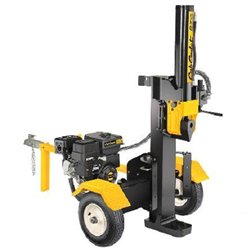Even if you’re used to doing your own repairs, it’s easy to be stumped when confronted with a log splitter. Even though the engine may be similar to what you use in other equipment, everything else is unique to these machines. Here’s what you need to know about keeping your Cub Cadet LS 27’s hydraulic pump healthy, addressing noises before they become major problems and storing your splitter so it will be ready for the next wood cutting season.
Tire Pressure
Recommended pressure varies between tire models and is printed on the sidewall. The rim can handle up to 30 PSI. Exceeding this pressure, even momentarily when seating the tire onto the rim, can cause the tire or rim to burst, leading to injuries.
Hydraulic Fluid
Check the fluid level in the reservoir tank before each use. Cub Cadet recommends using these hydraulic fluids in the LS 27:
Shell Tellus S2 M 32
Dexron III / Mercon automatic transmission fluid
Pro-Select AW-32 Hydraulic Oil
10WAW-ISO viscosity grade 32 hydraulic oil
It’s a good idea to use the same fluid to top up the system.
Change the hydraulic fluid and inlet filter after every 100 hours of use. The tank holds three gallons of fluid, and the entire hydraulic system holds 4.7 gallons.
1. Place a drain pan under the reservoir tank.
2. Disconnect the suction hose from the bottom rear of the tank. Let the fluid drain into the pan.
3. Unscrew the inlet filter from the tank opening. Coat the threads in a penetrating oil.
4. Install the new inlet filter and reattach the suction hose.
5. Add hydraulic fluid and check the level using the dipstick. Once full, install the dipstick cap.
6. Disconnect the spark plug and pull the recoil starter 10 times as far as it will travel to prime the pump.
7. Reconnect the spark plug and start the engine. Move the wedge to the furthest extended position and then back to the base of the hydraulic cylinder. Check the fluid level and add more hydraulic fluid as needed. Extend and retract the wedge 12 more times to bleed the air out of the system.
It’s normal for some fluid to come out of the vent hole as it expands from heat.
If you need to service any part of the hydraulic system, flush the tank and hoses with kerosene to remove any contaminants before adding new hydraulic fluid.
Flexible Pump Coupler
This nylon coupler connects the engine shaft to the hydraulic pump. The coupler will degrade with use and age; if it’s vibrating or making noise, it’s due for a replacement.
1. Disconnect the spark plug.
2. Remove the three lock nuts and screws connecting the coupling shield to the pump. Move the pump out of the way.
3. Loosen the set screw on the pump-side coupling half. Remove this coupling half.
4. Gently pull the starter handle on the engine until the set screw on the engine-side coupling half is facing down. Loosen the set screw and slide off the coupling half.
5. Slide the new coupling onto the engine shaft. The end of the shaft should be flush with the coupling half while still leaving space between the coupler and the engine support bracket. Tighten the set screw.
6. Slide the nylon spider onto the coupling half.
7. Slide the pump-side coupling half onto the shaft and rotate it so that the set screw is facing down. Leave the set screw loose for now.
8. Using the starting handle, rotate the engine shaft and spider until they line up with the pump-side coupling half. Slide the coupling half into place and insert the three mounting bolts.
9. Move the pump back into place and bolt it to the coupling.
10. Using a feeler gauge, set a clearance gap of 0.100 to 0.0600 inches between the spider and the engine coupling. Tighten the pump-side coupling set screw.
11. Reconnect the spark plug.
Storage
See your engine operator’s manual for instructions on preparing it for long-term storage. In most cases, you will need to drain the fuel tank, change the oil and lubricate the cylinder.
Clean the log splitter. Do not use a pressure washer or garden hose, as this can push water into bearings and seals, damaging these components.
Wipe down the machine with an oiled rag to create a moisture barrier. Pay particular attention to the wedge and beam.
Store the splitter in a clean, dry area away from flames, sparks and corrosive materials including fertilizer.
Need Parts for Your Cub Cadet?
Cubparts.com is an authorized Cub Cadet dealer, so we’re able to ship OEM parts for log splitters, mowers, snowblowers and anything else from the brand to any address in the U.S. or Canada. Ordering is easy thanks to our advanced search system: just select your model and serial number, and you’ll see factory diagrams and parts descriptions for your specific equipment.

